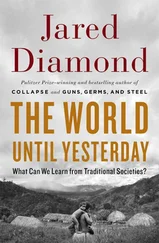Jared Diamond - Guns, Germs & Steel
Здесь есть возможность читать онлайн «Jared Diamond - Guns, Germs & Steel» весь текст электронной книги совершенно бесплатно (целиком полную версию без сокращений). В некоторых случаях можно слушать аудио, скачать через торрент в формате fb2 и присутствует краткое содержание. Жанр: 105. Описание произведения, (предисловие) а так же отзывы посетителей доступны на портале библиотеки ЛибКат.
- Название:Guns, Germs & Steel
- Автор:
- Жанр:
- Год:неизвестен
- ISBN:нет данных
- Рейтинг книги:5 / 5. Голосов: 1
-
Избранное:Добавить в избранное
- Отзывы:
-
Ваша оценка:
- 100
- 1
- 2
- 3
- 4
- 5
Guns, Germs & Steel: краткое содержание, описание и аннотация
Предлагаем к чтению аннотацию, описание, краткое содержание или предисловие (зависит от того, что написал сам автор книги «Guns, Germs & Steel»). Если вы не нашли необходимую информацию о книге — напишите в комментариях, мы постараемся отыскать её.
Guns, Germs & Steel — читать онлайн бесплатно полную книгу (весь текст) целиком
Ниже представлен текст книги, разбитый по страницам. Система сохранения места последней прочитанной страницы, позволяет с удобством читать онлайн бесплатно книгу «Guns, Germs & Steel», без необходимости каждый раз заново искать на чём Вы остановились. Поставьте закладку, и сможете в любой момент перейти на страницу, на которой закончили чтение.
Интервал:
Закладка:
144 ' GUNS, GERMS, AND STEEL
I patiently explained to my Fore companions that I had read about some mushrooms' being poisonous, that I had heard of even expert American mushroom collectors' dying because of the difficulty of distinguishing safe from dangerous mushrooms, and that although we were all hungry, it just wasn't worth the risk. At that point my companions got angry and told me to shut up and listen while they explained some things to me. After I had been quizzing them for years about names of hundreds of trees and birds, how could I insult them by assuming they didn't have names for different mushrooms? Only Americans could be so stupid as to confuse poisonous mushrooms with safe ones. They went on to lecture me about 29 types of edible mushroom species, each species' name in the Fore language, and where in the forest one should look for it. This one, the tdnti, grew on trees, and it was delicious and perfectly edible.
Whenever I have taken New Guineans with me to other parts of their island, they regularly talk about local plants and animals with other New Guineans whom they meet, and they gather potentially useful plants and bring them back to their home villages to try planting them. My experiences with New Guineans are paralleled by those of ethnobiologists studying traditional peoples elsewhere. However, all such peoples either practice at least some food production or are the partly acculturated last remnants of the world's former hunter-gatherer societies. Knowledge of wild species was presumably even more detailed before the rise of food production, when everyone on Earth still depended entirely on wild species for food. The first farmers were heirs to that knowledge, accumulated through tens of thousands of years of nature observation by biologically modern humans living in intimate dependence on the natural world. It therefore seems extremely unlikely that wild species of potential value would have escaped the notice of the first farmers.
The other, related question is whether ancient hunter-gatherers and farmers similarly put their ethnobiological knowledge to good use in selecting wild plants to gather and eventually to cultivate. One test comes from an archaeological site at the edge of the Euphrates Valley in Syria, called Tell Abu Hureyra. Between 10,000 and 9000 b.c. the people living there may already have been residing year-round in villages, but they were still hunter-gatherers; crop cultivation began only in the succeeding millennium. The archaeologists Gordon Hiliman, Susan Colledge, and David Harris retrieved large quantities of charred plant remains from the site, probably representing discarded garbage of wild plants gathered elsewhere
APPLES OR INDIANS • 145
and brought to the site by its residents. The scientists analyzed over 700 samples* each containing an average of over 500 identifiable seeds belonging to over 70 plant species. It turned out that the villagers were collecting a prodigious variety (157 species!) of plants identified by their charred seeds, not to mention other plants that cannot now be identified.
Were those naive villagers collecting every type of seed plant that they found, bringing it home, poisoning themselves on most of the species, and nourishing themselves from only a few species? No, they were not so silly. While 157 species sounds like indiscriminate collecting, many more species growing wild in the vicinity were absent from the charred remains. The 15" selected species fall into three categories. Many of them have seeds that are nonpoisonous and immediately edible. Others, such as pulses and members of the mustard family, have toxic seeds, but the toxins are easily removed, leaving the seeds edible. A few seeds belong to species traditionally used as sources of dyes or medicine. The many wild species not represented among the 157 selected are ones that would have been useless or harmful to people, including all of the most toxic weed species in the environment.
Thus, the hunter-gatherers of Tell Abu Hureyra were not wasting time and endangering themselves by collecting wild plants indiscriminately. Instead, they evidently knew the local wild plants as intimately as do modern New Guineans, and they used that knowledge to select and bring home only the most useful available seed plants. But those gathered seeds would have constituted the material for the unconscious first steps of plant domestication.
My other example of how ancient peoples apparently used their ethno-biological knowledge to good effect comes from the Jordan Valley in the ninth millennium b.c., the period of the earliest crop cultivation there. The valley's first domesticated cereals were barley and emmer wheat, which are still among the world's most productive crops today. But, as at Tell Abu Hureyra, hundreds of other seed-bearing wild plant species must have grown in the vicinity, and a hundred or more of them would have been edible and gathered before the rise of plant domestication. What was it about barley and emmer wheat that caused them to be the first crops? Were those first Jordan Valley farmers botanical ignoramuses who didn't know what they were doing? Or were barley and emmer wheat actually the best of the local wild cereals that they could have selected?
Two Israeli scientists, Ofer Bar-Yosef and Mordechai Kislev, tackled this
146 • GUNS, GERMS, AND STEEL
question by examining the wild grass species still growing wild in the valley today. Leaving aside species with small or unpalatable seeds, they picked out 23 of the most palatable and largest-seeded wild grasses. Not surprisingly, barley and emmer wheat were on that list.
But it wasn't true that the 21 other candidates would have been equally useful. Among those 23, barley and emmer wheat proved to be the best by many criteria. Emmer wheat has the biggest seeds and barley the second biggest. In the wild, barley is one of the 4 most abundant of the 23 species, while emmer wheat is of medium abundance. Barley has the further advantage that its genetics and morphology permit it to evolve quickly the useful changes in seed dispersal and germination inhibition that we discussed in the preceding chapter. Emmer wheat, however, has compensating virtues: it can be gathered more efficiently than barley, and it is unusual among cereals in that its seeds do not adhere to husks. As for the other 21 species, their drawbacks include smaller seeds, in many cases lower abundance, and in some cases their being perennial rather than annual plants, with the consequence that they would have evolved only slowly under domestication.
Thus, the first farmers in the Jordan Valley selected the 2 very best of the 23 best wild grass species available to them. Of course, the evolutionary changes (following cultivation) in seed dispersal and germination inhibition would have been unforeseen consequences of what those first farmers were doing. But their initial selection of barley and emmer wheat rather than other cereals to collect, bring home, and cultivate would have been conscious and based on the easily detected criteria of seed size, palat-ability, and abundance.
This example from the Jordan Valley, like that from Tell Abu Hureyra, illustrates that the first farmers used their detailed knowledge of local species to their own benefit. Knowing far more about local plants than all but a handful of modern professional botanists, they would hardly have failed to cultivate any useful wild plant species that was comparably suitable for domestication.
we can now examine what local farmers, in two parts of the world (New Guinea and the eastern United States) with indigenous but apparently deficient food production systems compared to that of the Fertile Crescent, actually did when more-productive crops arrived from else-
Интервал:
Закладка:
Похожие книги на «Guns, Germs & Steel»
Представляем Вашему вниманию похожие книги на «Guns, Germs & Steel» списком для выбора. Мы отобрали схожую по названию и смыслу литературу в надежде предоставить читателям больше вариантов отыскать новые, интересные, ещё непрочитанные произведения.
Обсуждение, отзывы о книге «Guns, Germs & Steel» и просто собственные мнения читателей. Оставьте ваши комментарии, напишите, что Вы думаете о произведении, его смысле или главных героях. Укажите что конкретно понравилось, а что нет, и почему Вы так считаете.










